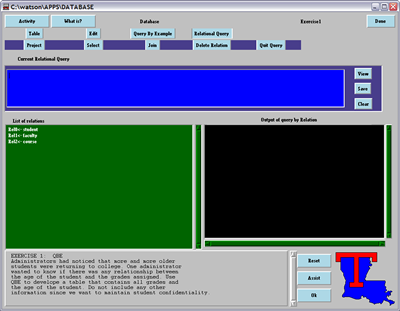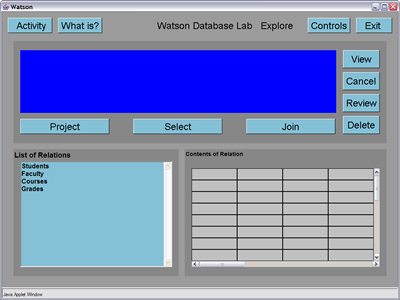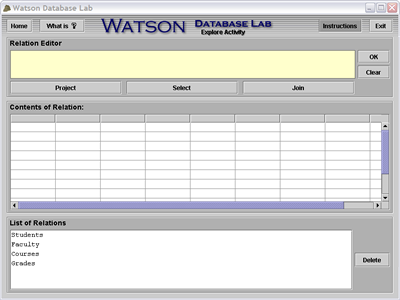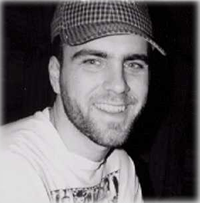
|
The number of faculty members and students who have contributed to the Watson Project over the years is truly amazing. Below, I have attempted to provide a comprehensive list – along with contact information where available – of those who have made Watson possible. If any Watson alumni out there are reading this page and notice that I have left someone out, or have outdated contact information, please contact me. The first person I would like to thank is Barry Kurtz. Watson would not exist without him. Barry came up with the original idea for a suite of labs to support a breadth-first introduction to computing – and then proceeded to convince me of both the value and feasibility of this approach. Barry was also the driving force behind convincing the National Science Foundation to initially fund the project. During the first phase of the Watson project, Don
Garrett and Alex Ramos were key members of the team. Don
and Alex implemented the library of shared code that was central
to the original C / SUIT lab prototypes. Other individuals
who contributed to the development of this phase of Watson
include: Pat Bronson,
Lee Falta, Michael Gaudet, Dr. Gary Klein, Josh
Kleinpeter, Dr. Barry
Kurtz, Jeff Matocha, Unmesh S. Mayekar, Dr.
Mike O'Neal, Alex Ramos, Dr. Louis Roemer, Vinay Shivaiah,
Sameer Singh, Charlie Stear, and Mark Williamson. Jayson Calloway, Cai Hong, and Byren Vaughn helped prototype a number of these Java-based labs. My “right hand man” for the third phase of Watson has been Cliff Lemoine. Cliff was invaluable in helping me to restart Watson development after a three-year lull resulting from my spending time in industry. Cliff helped tutor students in my CSC 100 classes, maintained the Phase II labs, and developed the object-oriented lab for Phase III. A special heart felt THANK YOU also goes out to my good friend and former student Don Garrett who, in addition to being a primary developer in Phase I of Watson, returned to Louisiana Tech to pursue a Master’s degree and in the process developed the Java Swing framework for Watson Phase III. Don’s years in industry developing object-oriented Java-based applications provided him with the background to lay a solid foundation for the current set of labs. Without Don’s efforts, Watson Phase III would not exist. The primary developers for Watson Phase III include: • Brandon George, Spreadsheet In addition to these developers, I’d like to thank the entire spring 2004 CSC 404 “Senior Capstone” class. This class did a spectacular job improving the look and feel of the Phase III labs, including developing all of the graphics, the user’s manual, brochure, CD case, flash-based web site, flash tutorials, and multi-platform (Windows, Mac, Linux) Watson CD. Additional efforts included: testing, bug tracking, bug fixes, and numerous improvements to the UI based on feedback collected from actual users. While all of those who worked so hard on this project deserve a BIG thank you, special recognition should be give to Jim Patterson (the Project Director), and Chris Martin and Louis Landry (who were jointly responsible for the “look” of Watson Phase III). To each and every one of you, “THANK YOU!” Dr. Mike O'Neal Watson development has taken place in three distinct phases: the first from 1993 through 1995, the second from 1996 to 1998, and the third phase from 2002 to 2004. Phase I (1993-1995)The first phase of Watson involved the conceptualization, design, and initial implementation of nine lab environments. During this time, Watson was support by a $100K grant from the National Science Foundation. A Watson Lab: Phase I (1993-1995) Watson’s core concepts
of a unified graphical user interface, cross platform compatibility,
breadth of concept coverage through the use of a suite of
independent labs, and depth of coverage within individual
labs by careful attention to the pedagogical content of individual
lab activities, were established early on. Phase II (1996-1998) By the mid-1990’s it became apparent that Watson needed
a total rewrite in order to become a viable teaching tool.
After several years of continuous classroom use, resulting
in feedback from hundreds of students, the Project Director
had a very clear idea of what worked and what didn’t.
Furthermore, the emergence of Java and explosion of web technologies
offered the hope of a stable cross-platform environment for
Watson. A Watson Lab: Phase II (1996-1998) The result of Phase II was a collection of stable, albeit
somewhat plain-looking labs, that could be accessed via web
browsers. These labs were used successfully in Louisiana Tech’s
CSC 100 courses for a number of years. Phase III (2002-2004) Upon return to academia in the Fall of 2001, four things
became apparent (1) Since the labs had been written in the
very early days of Java, they were no longer stable on modern
Java environments, (2) The look of the labs had become outdated
since they were not built with Swing components, (3) The pedagogical
content embodied in the Imperative lab was no longer as appropriate
as it had been in the mid-1990’s, and (4) The fact that
Watson contained zero coverage of object-oriented programming
concepts had become a serious omission. A Watson Lab: Phase III (2003-2004) During the spring of 2004, the Project
Director had the good fortune of teaching CSC 404 “Senior
Capstone”. In the spirit of “use every resource
at your disposal”, the Project Director selected Watson
as the topic for Senior Capstone. In addition to providing
desperately needed manpower for the Watson project, this choice
enabled the class to gain near-real-world experience with
a large project on the back end of the software design process.
The CSC 404 class devoted tremendous effort to testing, documentation,
and code maintenance. They tested the Phase III software with
actual students and incorporated UI changes based on the student’s
feedback. Furthermore the class refined the graphical “look”
of the labs and incorporated this look into the web and printed
documentation they developed.
In Memory of Jon J. WalkerIn the words of Kubrick's writer from A Clockwork Orange : He "…was a victim of the modern age."Watson Team |




